Crossrail Project: Evaluating BIM Strategy, Uses, and BSI Standards
VerifiedAdded on 2023/04/22
|10
|2248
|65
Report
AI Summary
This report delves into the Building Information Modelling (BIM) implementation within the Crossrail project, focusing on the strategy established for its adoption and its value proposition. It identifies and analyzes the specific BIM uses that were adopted across the project lifecycle, including the development of a Common Data Environment (CDE) and CAD systems, highlighting the benefits and challenges associated with each. The report also discusses planned BIM uses, such as spatial relationship management, and examines the purpose of British Standards Institution (BSI) standards in ensuring data standardization and interoperability. Ultimately, the report provides a comprehensive overview of how BIM was leveraged in the Crossrail project to facilitate design, construction, and information management, with recommendations for future implementations. Desklib provides past papers and solved assignments for students.

Running head: ICT FOR CONSTRUCTION MANAGEMENT
ICT for Construction Management
Name of Student
Name of University
Author Note
ICT for Construction Management
Name of Student
Name of University
Author Note
Paraphrase This Document
Need a fresh take? Get an instant paraphrase of this document with our AI Paraphraser

1
ICT FOR CONSTRUCTION MANAGEMENT
Table of Contents
Introduction..........................................................................................................................2
1. Overall Strategy established by Crossrail........................................................................2
2. BIM Uses that were adopted............................................................................................3
3. BIM Uses that were planned............................................................................................5
4. Purpose of BSI standards.................................................................................................6
Conclusion...........................................................................................................................6
Recommendations................................................................................................................7
References............................................................................................................................8
ICT FOR CONSTRUCTION MANAGEMENT
Table of Contents
Introduction..........................................................................................................................2
1. Overall Strategy established by Crossrail........................................................................2
2. BIM Uses that were adopted............................................................................................3
3. BIM Uses that were planned............................................................................................5
4. Purpose of BSI standards.................................................................................................6
Conclusion...........................................................................................................................6
Recommendations................................................................................................................7
References............................................................................................................................8
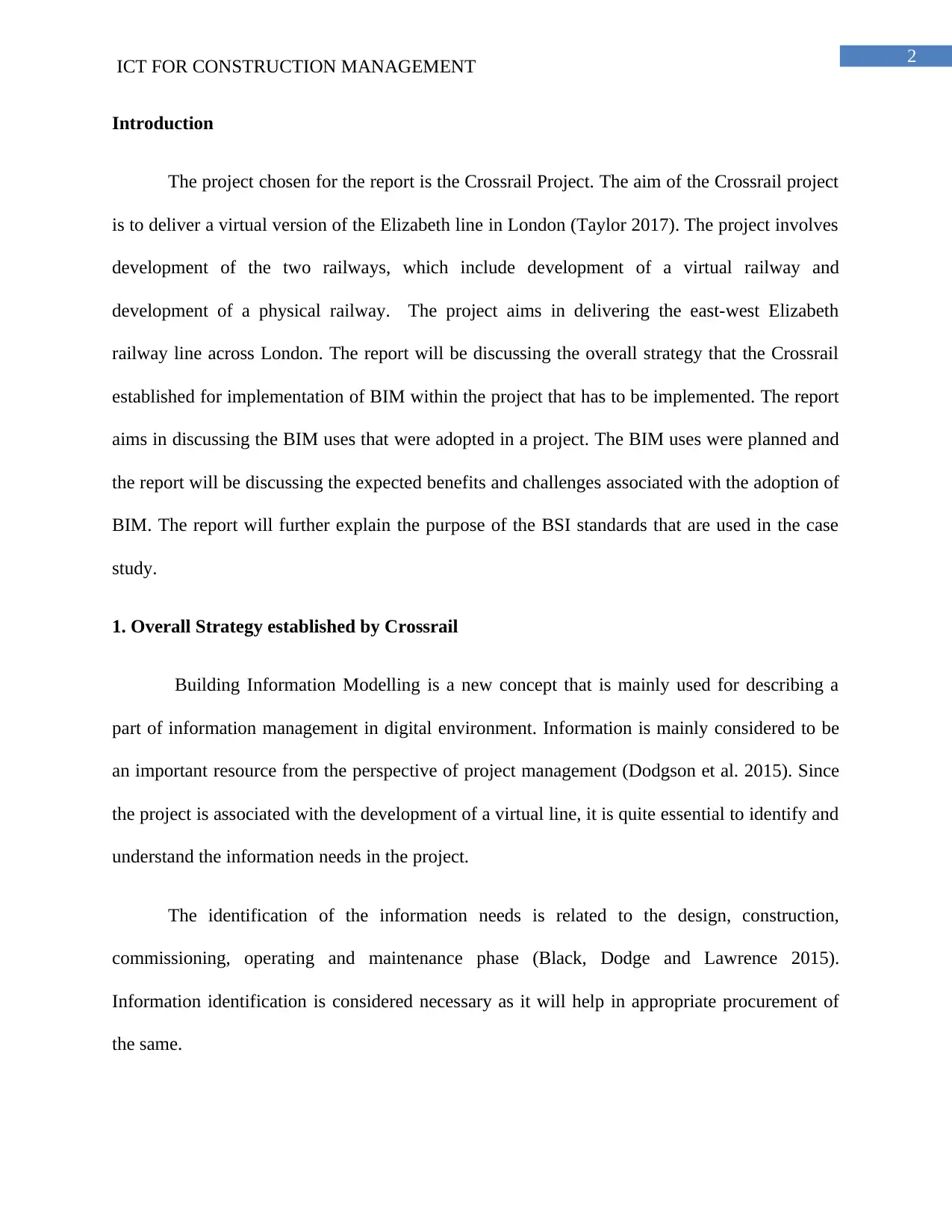
2
ICT FOR CONSTRUCTION MANAGEMENT
Introduction
The project chosen for the report is the Crossrail Project. The aim of the Crossrail project
is to deliver a virtual version of the Elizabeth line in London (Taylor 2017). The project involves
development of the two railways, which include development of a virtual railway and
development of a physical railway. The project aims in delivering the east-west Elizabeth
railway line across London. The report will be discussing the overall strategy that the Crossrail
established for implementation of BIM within the project that has to be implemented. The report
aims in discussing the BIM uses that were adopted in a project. The BIM uses were planned and
the report will be discussing the expected benefits and challenges associated with the adoption of
BIM. The report will further explain the purpose of the BSI standards that are used in the case
study.
1. Overall Strategy established by Crossrail
Building Information Modelling is a new concept that is mainly used for describing a
part of information management in digital environment. Information is mainly considered to be
an important resource from the perspective of project management (Dodgson et al. 2015). Since
the project is associated with the development of a virtual line, it is quite essential to identify and
understand the information needs in the project.
The identification of the information needs is related to the design, construction,
commissioning, operating and maintenance phase (Black, Dodge and Lawrence 2015).
Information identification is considered necessary as it will help in appropriate procurement of
the same.
ICT FOR CONSTRUCTION MANAGEMENT
Introduction
The project chosen for the report is the Crossrail Project. The aim of the Crossrail project
is to deliver a virtual version of the Elizabeth line in London (Taylor 2017). The project involves
development of the two railways, which include development of a virtual railway and
development of a physical railway. The project aims in delivering the east-west Elizabeth
railway line across London. The report will be discussing the overall strategy that the Crossrail
established for implementation of BIM within the project that has to be implemented. The report
aims in discussing the BIM uses that were adopted in a project. The BIM uses were planned and
the report will be discussing the expected benefits and challenges associated with the adoption of
BIM. The report will further explain the purpose of the BSI standards that are used in the case
study.
1. Overall Strategy established by Crossrail
Building Information Modelling is a new concept that is mainly used for describing a
part of information management in digital environment. Information is mainly considered to be
an important resource from the perspective of project management (Dodgson et al. 2015). Since
the project is associated with the development of a virtual line, it is quite essential to identify and
understand the information needs in the project.
The identification of the information needs is related to the design, construction,
commissioning, operating and maintenance phase (Black, Dodge and Lawrence 2015).
Information identification is considered necessary as it will help in appropriate procurement of
the same.
⊘ This is a preview!⊘
Do you want full access?
Subscribe today to unlock all pages.

Trusted by 1+ million students worldwide

3
ICT FOR CONSTRUCTION MANAGEMENT
For understanding the digital information needs of a particular project, Crossrail
implemented BIM within their project. Building Information Modelling is seen as a technique of
management of digital information related to the railway assets. As a strategy of implementing
BIM in their project, Crossrail has made use of spatial modelling techniques including a
particular information system and a computer aided design in 3D that is linked to the database
storing the reliable information.
During the project life cycle, a large amount of digital data is being created and shared.
The availability and the visibility of the collected information is managed by Crossrail by
making use of CDE. It is an effective strategy as CDE is a place from which information and it
provides a platform for easier data sharing, storing and accessing of the data (Davies et al. 2014).
CDE is therefore considered to be ideal for promoting a collaborative working culture, which is
quite necessary for the Crossrail project.
The use of CDE has contributed in value proposition of the project with appropriate
sorting of the digital information related to the project. CDE mainly three data types related to it,
which include graphical model, non-graphical data and documents. The data availability in good
structured in Crossrail began for the Crossrail project in the year 1990s.
2. BIM Uses that were adopted
This section of the report discusses, defines, describes and analyses the BIM uses that
have been adopted across the different project lifecycle phases (Pickett 2015). Business
Information Modelling or BIM is mainly described as the process of creation and management of
a particular data with identity and relationship (Yeow et al. 2014). BIM is linked with project
management life cycle mainly because it allows high integration of information and efficient
ICT FOR CONSTRUCTION MANAGEMENT
For understanding the digital information needs of a particular project, Crossrail
implemented BIM within their project. Building Information Modelling is seen as a technique of
management of digital information related to the railway assets. As a strategy of implementing
BIM in their project, Crossrail has made use of spatial modelling techniques including a
particular information system and a computer aided design in 3D that is linked to the database
storing the reliable information.
During the project life cycle, a large amount of digital data is being created and shared.
The availability and the visibility of the collected information is managed by Crossrail by
making use of CDE. It is an effective strategy as CDE is a place from which information and it
provides a platform for easier data sharing, storing and accessing of the data (Davies et al. 2014).
CDE is therefore considered to be ideal for promoting a collaborative working culture, which is
quite necessary for the Crossrail project.
The use of CDE has contributed in value proposition of the project with appropriate
sorting of the digital information related to the project. CDE mainly three data types related to it,
which include graphical model, non-graphical data and documents. The data availability in good
structured in Crossrail began for the Crossrail project in the year 1990s.
2. BIM Uses that were adopted
This section of the report discusses, defines, describes and analyses the BIM uses that
have been adopted across the different project lifecycle phases (Pickett 2015). Business
Information Modelling or BIM is mainly described as the process of creation and management of
a particular data with identity and relationship (Yeow et al. 2014). BIM is linked with project
management life cycle mainly because it allows high integration of information and efficient
Paraphrase This Document
Need a fresh take? Get an instant paraphrase of this document with our AI Paraphraser

4
ICT FOR CONSTRUCTION MANAGEMENT
information management. This is one of the most significant reasons that contributed to the
adoption of the BIM in Crossrail project.
Since the BIM characteristics mainly include development of a common data
environment, the application of BIM in Crossrail project is related to the development of CDE at
first. As discussed earlier, a CDE can be described as a place where information is stored.
The BIM in the Crossrail project is considered as a technique of creation and
management of the digital information that is needed in the project life cycle. While the project
is being implemented, the Crossrail Limited took the very first step of developing a CDE in
2008, by creating a single CAD system. This CAD system that is developed is used by all the
designers of the project. The use of the developed CAD system helped in better adoption of BIM
as the CAD helped the designers of the project to collaborate among themselves. After
development of the first part of the CDE required for effective BIM, the Crossrail limited
appointed 23 major design framework consultant for undertaking a full detailed design of the
project. Along with that a single running CAD services that is developed helped in ensuring a
consistent design across the consistent CAD standard. This is one of the most effective strategies
undertaken in relation to the BIM uses in the Crossrail project. The functional CAD was mainly
developed in the initiation phase in the project life cycle. In the later stages of project lifecycle, a
centralised CAD application was developed. During the construction phase, the Crossrail limited
had made use of current civil and structural models. The 3D models that are developed as a part
of CAD workflows were kept up to date. Effective BIM uses has helped in successful completion
of the same.
ICT FOR CONSTRUCTION MANAGEMENT
information management. This is one of the most significant reasons that contributed to the
adoption of the BIM in Crossrail project.
Since the BIM characteristics mainly include development of a common data
environment, the application of BIM in Crossrail project is related to the development of CDE at
first. As discussed earlier, a CDE can be described as a place where information is stored.
The BIM in the Crossrail project is considered as a technique of creation and
management of the digital information that is needed in the project life cycle. While the project
is being implemented, the Crossrail Limited took the very first step of developing a CDE in
2008, by creating a single CAD system. This CAD system that is developed is used by all the
designers of the project. The use of the developed CAD system helped in better adoption of BIM
as the CAD helped the designers of the project to collaborate among themselves. After
development of the first part of the CDE required for effective BIM, the Crossrail limited
appointed 23 major design framework consultant for undertaking a full detailed design of the
project. Along with that a single running CAD services that is developed helped in ensuring a
consistent design across the consistent CAD standard. This is one of the most effective strategies
undertaken in relation to the BIM uses in the Crossrail project. The functional CAD was mainly
developed in the initiation phase in the project life cycle. In the later stages of project lifecycle, a
centralised CAD application was developed. During the construction phase, the Crossrail limited
had made use of current civil and structural models. The 3D models that are developed as a part
of CAD workflows were kept up to date. Effective BIM uses has helped in successful completion
of the same.
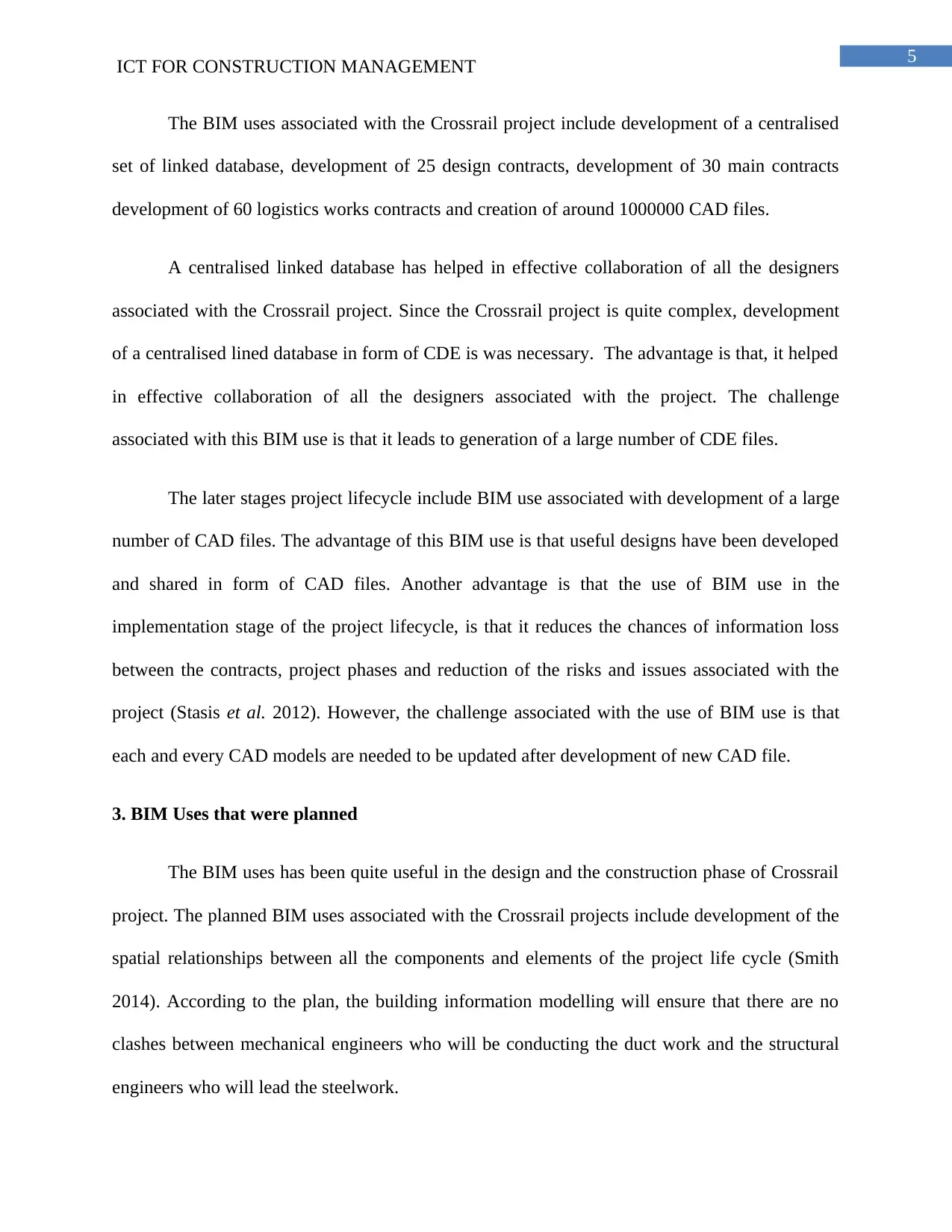
5
ICT FOR CONSTRUCTION MANAGEMENT
The BIM uses associated with the Crossrail project include development of a centralised
set of linked database, development of 25 design contracts, development of 30 main contracts
development of 60 logistics works contracts and creation of around 1000000 CAD files.
A centralised linked database has helped in effective collaboration of all the designers
associated with the Crossrail project. Since the Crossrail project is quite complex, development
of a centralised lined database in form of CDE is was necessary. The advantage is that, it helped
in effective collaboration of all the designers associated with the project. The challenge
associated with this BIM use is that it leads to generation of a large number of CDE files.
The later stages project lifecycle include BIM use associated with development of a large
number of CAD files. The advantage of this BIM use is that useful designs have been developed
and shared in form of CAD files. Another advantage is that the use of BIM use in the
implementation stage of the project lifecycle, is that it reduces the chances of information loss
between the contracts, project phases and reduction of the risks and issues associated with the
project (Stasis et al. 2012). However, the challenge associated with the use of BIM use is that
each and every CAD models are needed to be updated after development of new CAD file.
3. BIM Uses that were planned
The BIM uses has been quite useful in the design and the construction phase of Crossrail
project. The planned BIM uses associated with the Crossrail projects include development of the
spatial relationships between all the components and elements of the project life cycle (Smith
2014). According to the plan, the building information modelling will ensure that there are no
clashes between mechanical engineers who will be conducting the duct work and the structural
engineers who will lead the steelwork.
ICT FOR CONSTRUCTION MANAGEMENT
The BIM uses associated with the Crossrail project include development of a centralised
set of linked database, development of 25 design contracts, development of 30 main contracts
development of 60 logistics works contracts and creation of around 1000000 CAD files.
A centralised linked database has helped in effective collaboration of all the designers
associated with the Crossrail project. Since the Crossrail project is quite complex, development
of a centralised lined database in form of CDE is was necessary. The advantage is that, it helped
in effective collaboration of all the designers associated with the project. The challenge
associated with this BIM use is that it leads to generation of a large number of CDE files.
The later stages project lifecycle include BIM use associated with development of a large
number of CAD files. The advantage of this BIM use is that useful designs have been developed
and shared in form of CAD files. Another advantage is that the use of BIM use in the
implementation stage of the project lifecycle, is that it reduces the chances of information loss
between the contracts, project phases and reduction of the risks and issues associated with the
project (Stasis et al. 2012). However, the challenge associated with the use of BIM use is that
each and every CAD models are needed to be updated after development of new CAD file.
3. BIM Uses that were planned
The BIM uses has been quite useful in the design and the construction phase of Crossrail
project. The planned BIM uses associated with the Crossrail projects include development of the
spatial relationships between all the components and elements of the project life cycle (Smith
2014). According to the plan, the building information modelling will ensure that there are no
clashes between mechanical engineers who will be conducting the duct work and the structural
engineers who will lead the steelwork.
⊘ This is a preview!⊘
Do you want full access?
Subscribe today to unlock all pages.

Trusted by 1+ million students worldwide
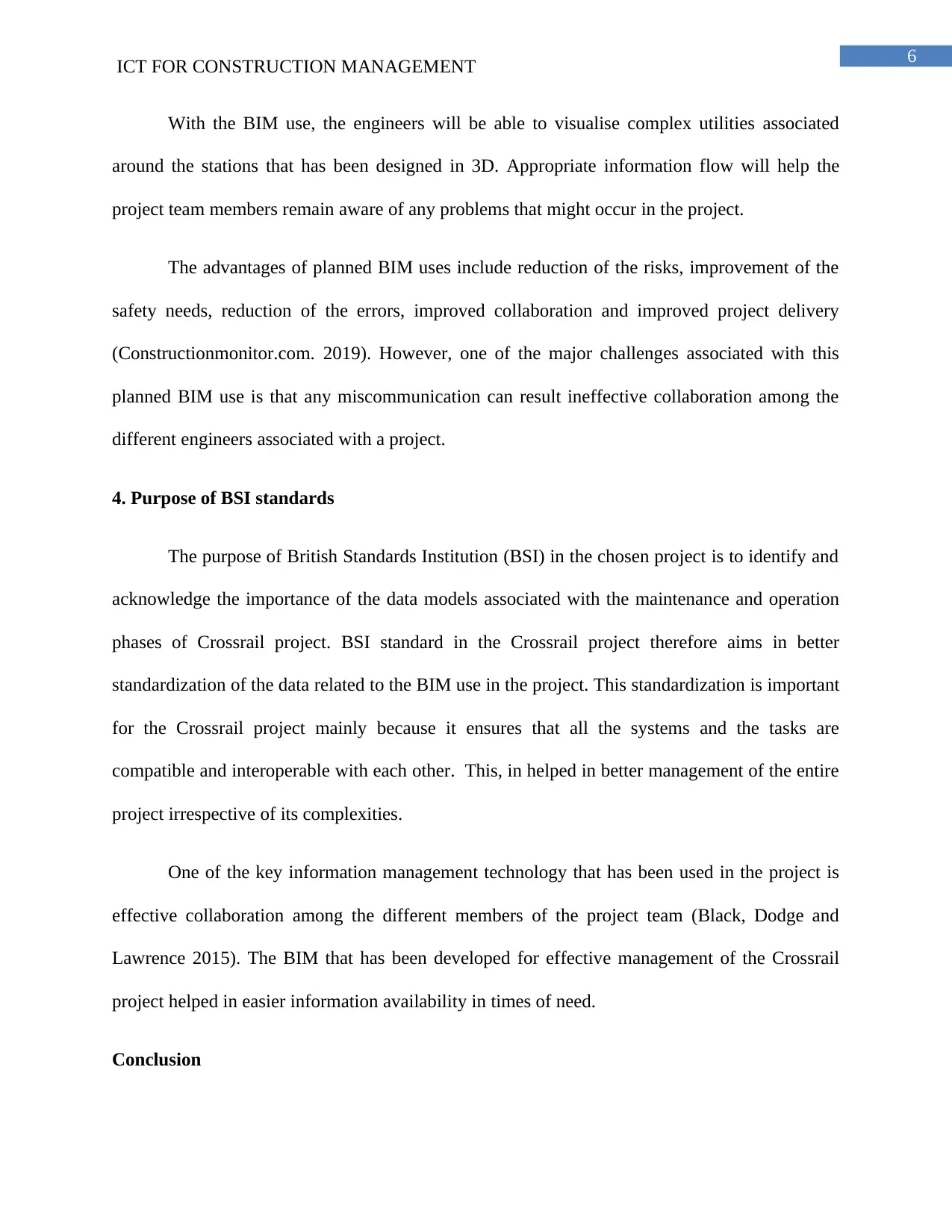
6
ICT FOR CONSTRUCTION MANAGEMENT
With the BIM use, the engineers will be able to visualise complex utilities associated
around the stations that has been designed in 3D. Appropriate information flow will help the
project team members remain aware of any problems that might occur in the project.
The advantages of planned BIM uses include reduction of the risks, improvement of the
safety needs, reduction of the errors, improved collaboration and improved project delivery
(Constructionmonitor.com. 2019). However, one of the major challenges associated with this
planned BIM use is that any miscommunication can result ineffective collaboration among the
different engineers associated with a project.
4. Purpose of BSI standards
The purpose of British Standards Institution (BSI) in the chosen project is to identify and
acknowledge the importance of the data models associated with the maintenance and operation
phases of Crossrail project. BSI standard in the Crossrail project therefore aims in better
standardization of the data related to the BIM use in the project. This standardization is important
for the Crossrail project mainly because it ensures that all the systems and the tasks are
compatible and interoperable with each other. This, in helped in better management of the entire
project irrespective of its complexities.
One of the key information management technology that has been used in the project is
effective collaboration among the different members of the project team (Black, Dodge and
Lawrence 2015). The BIM that has been developed for effective management of the Crossrail
project helped in easier information availability in times of need.
Conclusion
ICT FOR CONSTRUCTION MANAGEMENT
With the BIM use, the engineers will be able to visualise complex utilities associated
around the stations that has been designed in 3D. Appropriate information flow will help the
project team members remain aware of any problems that might occur in the project.
The advantages of planned BIM uses include reduction of the risks, improvement of the
safety needs, reduction of the errors, improved collaboration and improved project delivery
(Constructionmonitor.com. 2019). However, one of the major challenges associated with this
planned BIM use is that any miscommunication can result ineffective collaboration among the
different engineers associated with a project.
4. Purpose of BSI standards
The purpose of British Standards Institution (BSI) in the chosen project is to identify and
acknowledge the importance of the data models associated with the maintenance and operation
phases of Crossrail project. BSI standard in the Crossrail project therefore aims in better
standardization of the data related to the BIM use in the project. This standardization is important
for the Crossrail project mainly because it ensures that all the systems and the tasks are
compatible and interoperable with each other. This, in helped in better management of the entire
project irrespective of its complexities.
One of the key information management technology that has been used in the project is
effective collaboration among the different members of the project team (Black, Dodge and
Lawrence 2015). The BIM that has been developed for effective management of the Crossrail
project helped in easier information availability in times of need.
Conclusion
Paraphrase This Document
Need a fresh take? Get an instant paraphrase of this document with our AI Paraphraser
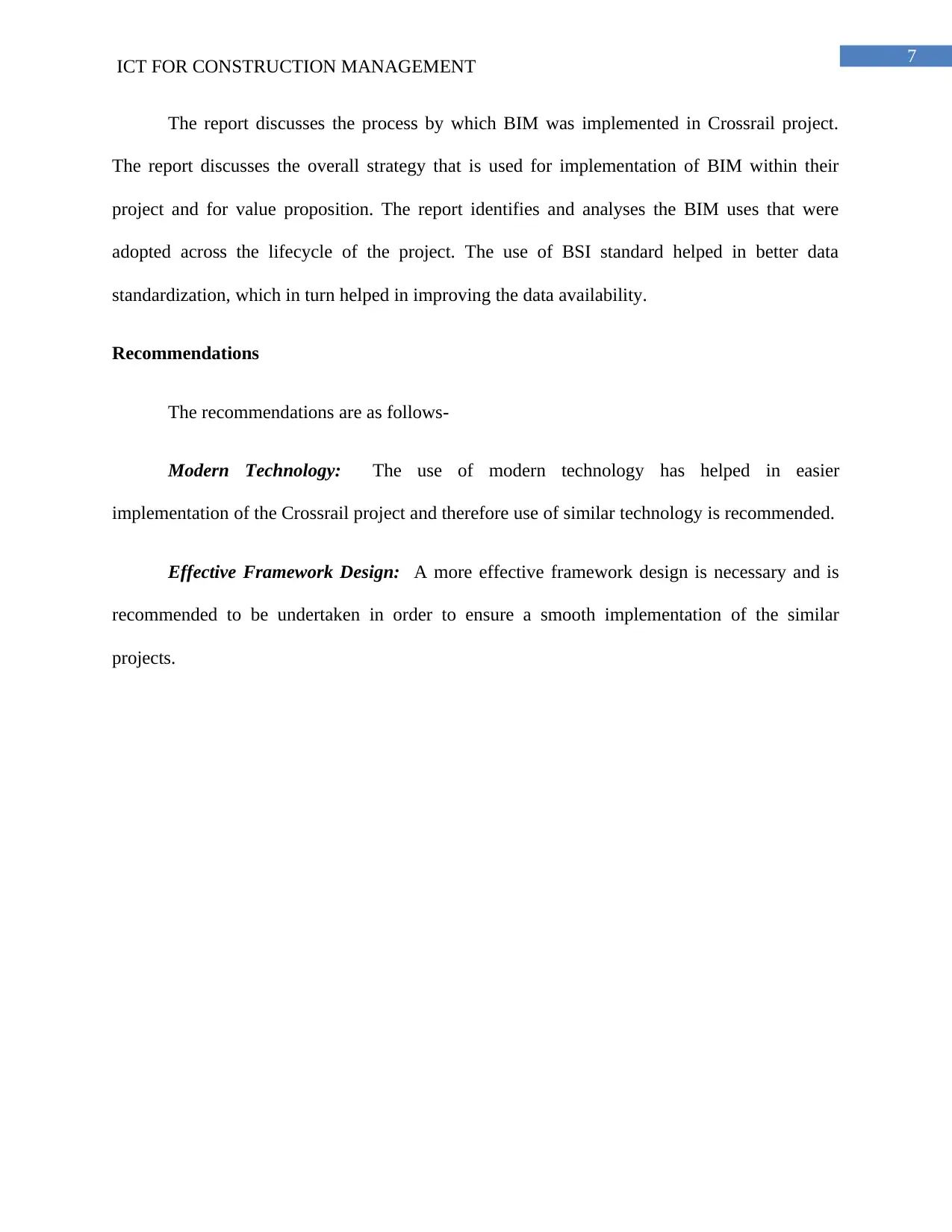
7
ICT FOR CONSTRUCTION MANAGEMENT
The report discusses the process by which BIM was implemented in Crossrail project.
The report discusses the overall strategy that is used for implementation of BIM within their
project and for value proposition. The report identifies and analyses the BIM uses that were
adopted across the lifecycle of the project. The use of BSI standard helped in better data
standardization, which in turn helped in improving the data availability.
Recommendations
The recommendations are as follows-
Modern Technology: The use of modern technology has helped in easier
implementation of the Crossrail project and therefore use of similar technology is recommended.
Effective Framework Design: A more effective framework design is necessary and is
recommended to be undertaken in order to ensure a smooth implementation of the similar
projects.
ICT FOR CONSTRUCTION MANAGEMENT
The report discusses the process by which BIM was implemented in Crossrail project.
The report discusses the overall strategy that is used for implementation of BIM within their
project and for value proposition. The report identifies and analyses the BIM uses that were
adopted across the lifecycle of the project. The use of BSI standard helped in better data
standardization, which in turn helped in improving the data availability.
Recommendations
The recommendations are as follows-
Modern Technology: The use of modern technology has helped in easier
implementation of the Crossrail project and therefore use of similar technology is recommended.
Effective Framework Design: A more effective framework design is necessary and is
recommended to be undertaken in order to ensure a smooth implementation of the similar
projects.
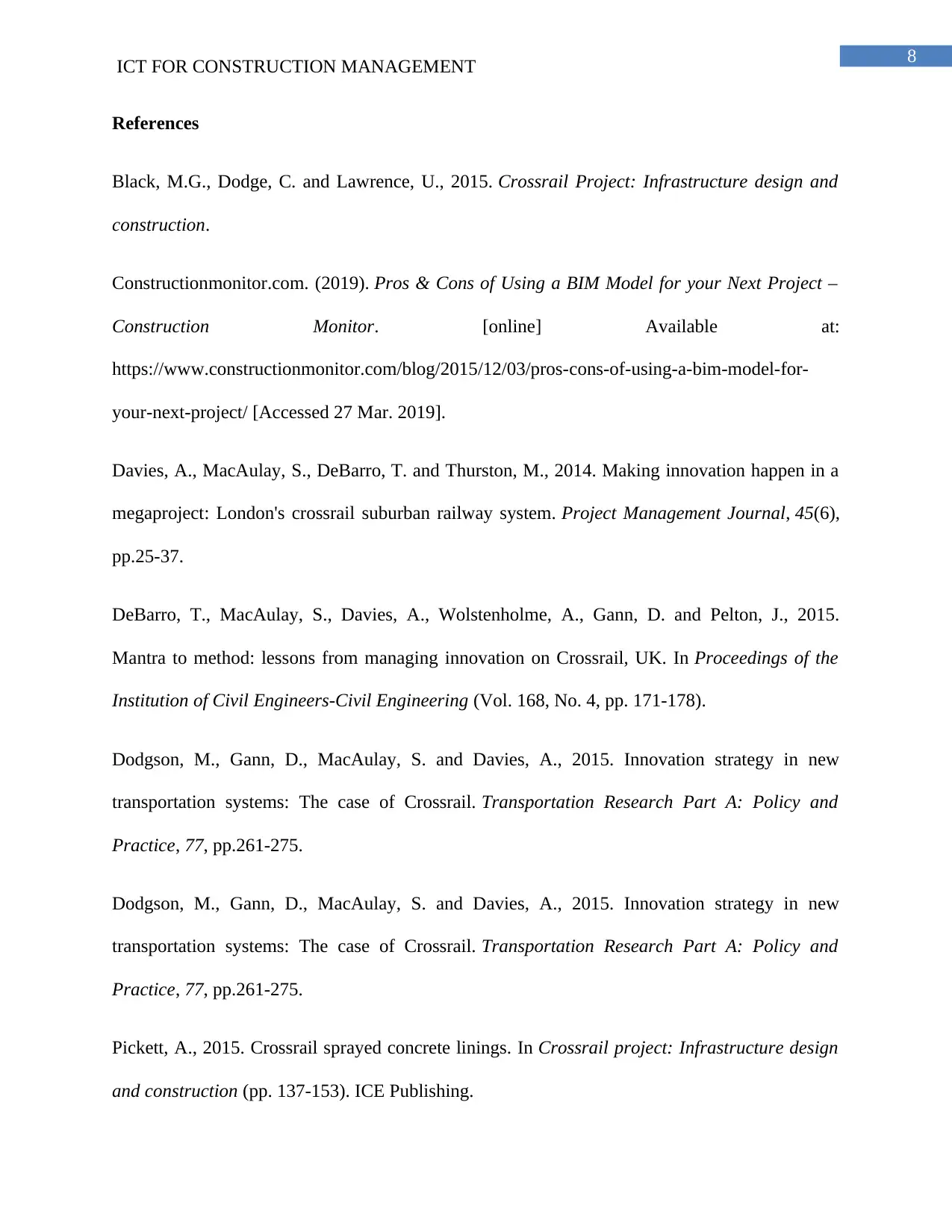
8
ICT FOR CONSTRUCTION MANAGEMENT
References
Black, M.G., Dodge, C. and Lawrence, U., 2015. Crossrail Project: Infrastructure design and
construction.
Constructionmonitor.com. (2019). Pros & Cons of Using a BIM Model for your Next Project –
Construction Monitor. [online] Available at:
https://www.constructionmonitor.com/blog/2015/12/03/pros-cons-of-using-a-bim-model-for-
your-next-project/ [Accessed 27 Mar. 2019].
Davies, A., MacAulay, S., DeBarro, T. and Thurston, M., 2014. Making innovation happen in a
megaproject: London's crossrail suburban railway system. Project Management Journal, 45(6),
pp.25-37.
DeBarro, T., MacAulay, S., Davies, A., Wolstenholme, A., Gann, D. and Pelton, J., 2015.
Mantra to method: lessons from managing innovation on Crossrail, UK. In Proceedings of the
Institution of Civil Engineers-Civil Engineering (Vol. 168, No. 4, pp. 171-178).
Dodgson, M., Gann, D., MacAulay, S. and Davies, A., 2015. Innovation strategy in new
transportation systems: The case of Crossrail. Transportation Research Part A: Policy and
Practice, 77, pp.261-275.
Dodgson, M., Gann, D., MacAulay, S. and Davies, A., 2015. Innovation strategy in new
transportation systems: The case of Crossrail. Transportation Research Part A: Policy and
Practice, 77, pp.261-275.
Pickett, A., 2015. Crossrail sprayed concrete linings. In Crossrail project: Infrastructure design
and construction (pp. 137-153). ICE Publishing.
ICT FOR CONSTRUCTION MANAGEMENT
References
Black, M.G., Dodge, C. and Lawrence, U., 2015. Crossrail Project: Infrastructure design and
construction.
Constructionmonitor.com. (2019). Pros & Cons of Using a BIM Model for your Next Project –
Construction Monitor. [online] Available at:
https://www.constructionmonitor.com/blog/2015/12/03/pros-cons-of-using-a-bim-model-for-
your-next-project/ [Accessed 27 Mar. 2019].
Davies, A., MacAulay, S., DeBarro, T. and Thurston, M., 2014. Making innovation happen in a
megaproject: London's crossrail suburban railway system. Project Management Journal, 45(6),
pp.25-37.
DeBarro, T., MacAulay, S., Davies, A., Wolstenholme, A., Gann, D. and Pelton, J., 2015.
Mantra to method: lessons from managing innovation on Crossrail, UK. In Proceedings of the
Institution of Civil Engineers-Civil Engineering (Vol. 168, No. 4, pp. 171-178).
Dodgson, M., Gann, D., MacAulay, S. and Davies, A., 2015. Innovation strategy in new
transportation systems: The case of Crossrail. Transportation Research Part A: Policy and
Practice, 77, pp.261-275.
Dodgson, M., Gann, D., MacAulay, S. and Davies, A., 2015. Innovation strategy in new
transportation systems: The case of Crossrail. Transportation Research Part A: Policy and
Practice, 77, pp.261-275.
Pickett, A., 2015. Crossrail sprayed concrete linings. In Crossrail project: Infrastructure design
and construction (pp. 137-153). ICE Publishing.
⊘ This is a preview!⊘
Do you want full access?
Subscribe today to unlock all pages.

Trusted by 1+ million students worldwide

9
ICT FOR CONSTRUCTION MANAGEMENT
Smith, S., 2014. Building information modelling–moving Crossrail, UK, forward. Proceedings
of the Institution of Civil Engineers-Management, Procurement and Law, 167(3), pp.141-151.
Stasis, A., Whyte, J., Stephens, E. and Dentten, R., 2012. Building Information Modelling and
Management in Infrastructure Programmes: A Scoping Study in Crossrail. In Technologies for
Sustainable Built Environments Engineering Doctorate Conference.
Taylor, M., 2017, November. Crossrail project: building a virtual version of London’s Elizabeth
line. In Proceedings of the Institution of Civil Engineers-Civil Engineering (Vol. 170, No. 6, pp.
56-63). Thomas Telford Ltd.
Yeow, H.C., Nicholson, D., Man, C.L., Ringer, A., Glass, P. and Black, M., 2014. Application of
observational method at Crossrail Tottenham Court Road station, UK. Proceedings of the
Institution of Civil Engineers-Geotechnical Engineering, 167(2), pp.182-193.
ICT FOR CONSTRUCTION MANAGEMENT
Smith, S., 2014. Building information modelling–moving Crossrail, UK, forward. Proceedings
of the Institution of Civil Engineers-Management, Procurement and Law, 167(3), pp.141-151.
Stasis, A., Whyte, J., Stephens, E. and Dentten, R., 2012. Building Information Modelling and
Management in Infrastructure Programmes: A Scoping Study in Crossrail. In Technologies for
Sustainable Built Environments Engineering Doctorate Conference.
Taylor, M., 2017, November. Crossrail project: building a virtual version of London’s Elizabeth
line. In Proceedings of the Institution of Civil Engineers-Civil Engineering (Vol. 170, No. 6, pp.
56-63). Thomas Telford Ltd.
Yeow, H.C., Nicholson, D., Man, C.L., Ringer, A., Glass, P. and Black, M., 2014. Application of
observational method at Crossrail Tottenham Court Road station, UK. Proceedings of the
Institution of Civil Engineers-Geotechnical Engineering, 167(2), pp.182-193.
1 out of 10
Related Documents
Your All-in-One AI-Powered Toolkit for Academic Success.
+13062052269
info@desklib.com
Available 24*7 on WhatsApp / Email
![[object Object]](/_next/static/media/star-bottom.7253800d.svg)
Unlock your academic potential
Copyright © 2020–2025 A2Z Services. All Rights Reserved. Developed and managed by ZUCOL.




